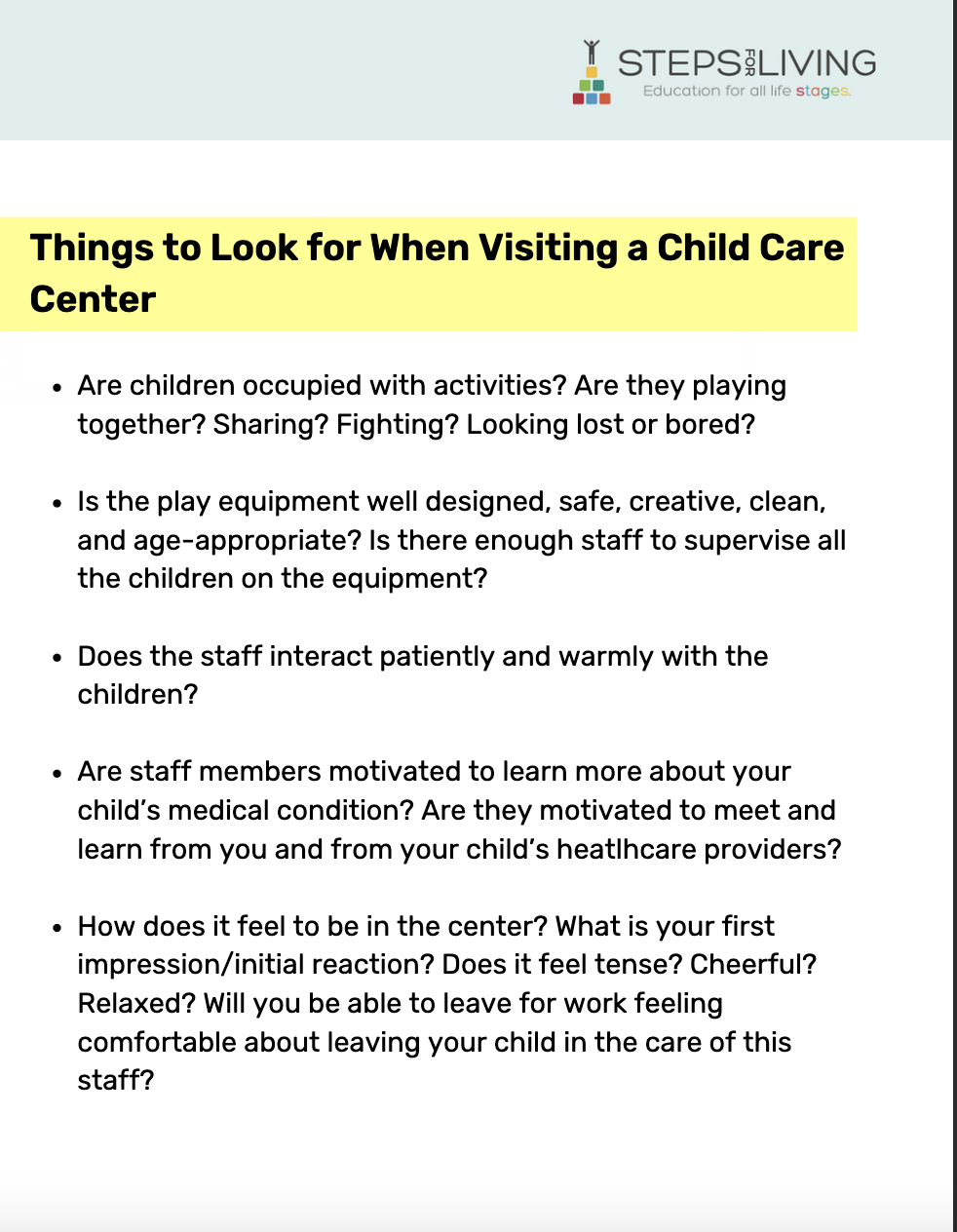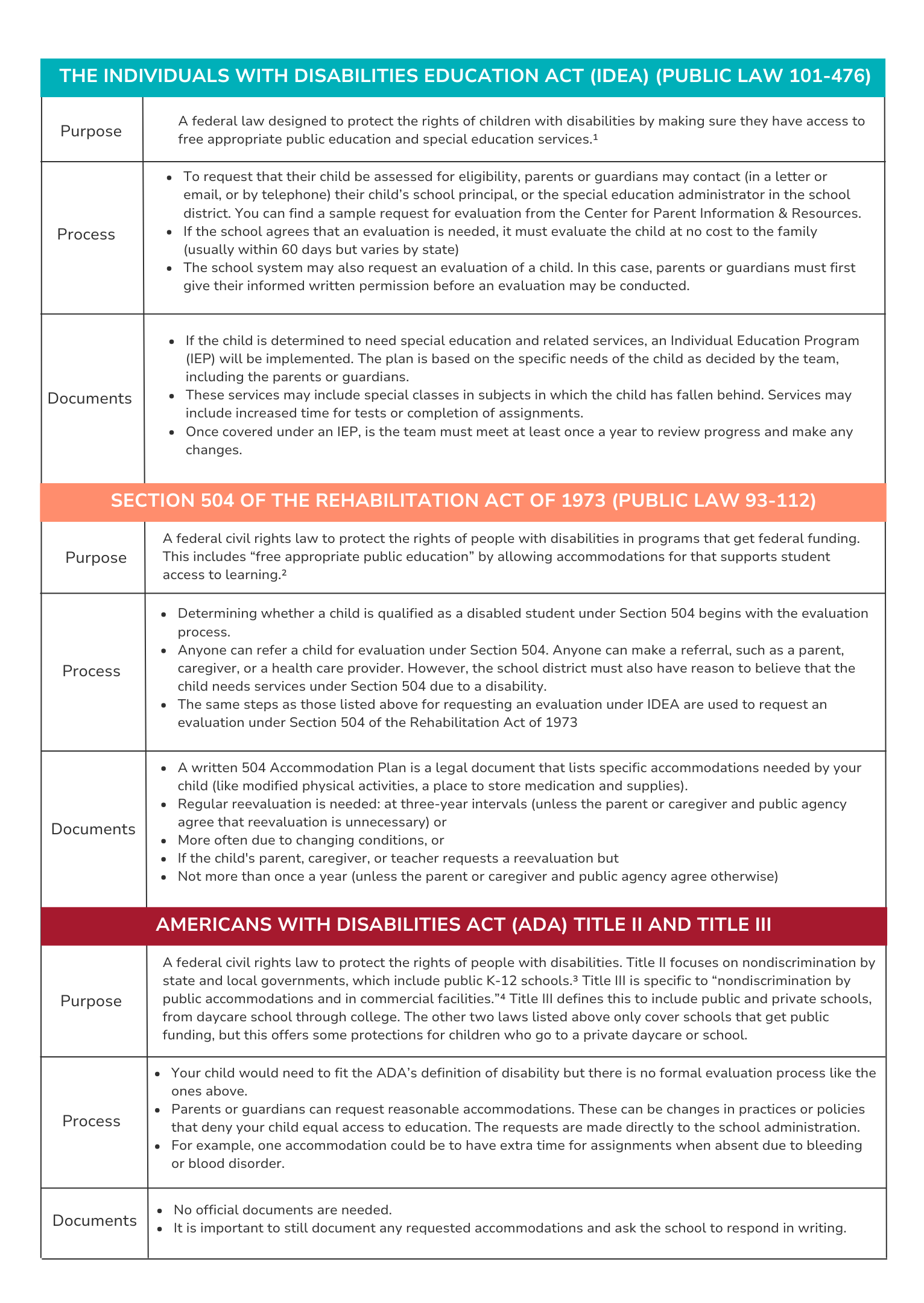This section covers:
School Accommodations and Working with Your School
Educational Rights

Your child’s right to a proper education is protected under two important federal laws, the Individuals with Disabilities Education Act (IDEA), and Section 504 of the Rehabilitation Act of 1973.These laws are described in detail below.
If you want more information on these different laws, visit the ADA National Networks “Disability Rights Laws in Public Primary and Secondary Education: How Do They Relate?”.
These laws are federal, which means for the whole country. States must meet these standards. States do have some areas they get to interpret the federal law for their state. This means steps to take action under these laws might be slightly different state by state. Some states also offer more protections than the federal law. It can be important to learn about specifics for the state you live in. You can find more information about your state at a Parent Training and Information Center or a Community Parent Resource Center.
Understanding the Plans
The section above covers what the laws and rights are, but here is more information on what to include in the different plans and resources.
Individual Education Plan (IEP)
A legal document listing accommodations for a student who needs special education services due to their disability. Such services may include:
- Individualized classroom behavior plan
- Small-group testing
- More time for tests
As noted in the chart above, there are multiple steps. Many people might be involved from parents and caregivers to teachers and school administrators. For more information on IEPs you can reach out to your Hemophilia Treatment Center (HTC) or go to these resources:
- Center for Parent Information & Resources “Developing Your Child’s IEP”
- Understood’s “Understanding IEPs”
504 Accommodation Plan
A legal document listing specific accommodations for a disabled student. Such accommodations may include:
- An extra set of books at home or school
- A rolling backpack
- Modified physical education
- Extra time to complete assignments when absent
For more information on 504 plans, you can reach out to your HTC or visit these resources:
- U.S. Department of Education Office for Civil Rights “Parent and Education Resource Guide to Section 504 in Public Elementary and Secondary Schools”
- Understood’s “What is a 504 Plan?”
Individualized Health Care Plan (IHP)
There is one more type of plan that can be helpful in working with your child’s school. It wasn’t listed in the chart above because it doesn’t come from federal law. Not all states have them, but some do as part of state law. They are usually overseen by school nurses and focus narrowly on medical needs, not broader access, or educational needs. It may include:
- Specific instructions for meeting a student’s medical needs at school Storage of medication
- What to do in case of a medical incident or emergency
If you want more information about IHP plans, you can reach out to your HTC or use this template:
School Accommodations and Working with Your School
Here are some things to keep in mind when working with your school on your child’s accommodations.
By law your school must help you develop this plan. If you have questions, don't be afraid to ask. Continue to ask until you completely understand the process and the IEP. It is important to understand how the plan meets your child’s needs. You can also ask for the documents to be in your preferred language and for interpretation at any meetings if needed. Do not sign an IEP unless you understand and agree with its contents.
Make suggestions. Speak up if you feel a goal, objective, or accommodation is not right for your child.
When possible, get written documentation from teachers, administrators, or other professionals working with your child about their behavioral or academic concerns.
This should include any written documentation you have received. Keep records of communication between home and school, progress reports, and evaluations. You should also keep a copy of any letter you send to the school. Keep these records well organized and in one place. You may need them in the future.
Schedule meetings to make sure you and school staff are on the same page with your child’s progress and IEP or 504 plan. Ask them how to best keep open communication. This could be by e-mail, parent portal or app, in-person meetings, or a communication notebook.
Help your child create a system for completing homework assignments and other school projects.
- Is there a locked cabinet for the medication and supplies?
- Who oversees keeping medications safe?
- What training did the school nurse or health staff receive?
- Did they attend any trainings? These trainings could be by a parent or caregiver of a child with a bleeding disorder, the Hemophilia Treatment Center (HTC), or local bleeding disorder organization.
- What are the procedures in the case of a medical emergency in a classroom or on the school campus?
- Does the school understand when they should notify the emergency contact, call the HTC, or go to an emergency department (ED)?
- Who is responsible for making sure these procedures happen?
- Has the school staff received training in medical emergency procedures?
- What kind of training was it?
- How many staff members are trained?
- Is trained staff available at the school full time (or even part time)?
- Is a procedure in place for when the trained staff is absent?
- Department of Justice, Civil Rights Division. (2012, March 8). Americans with Disabilities Act Title III Regulations. ADA.gov. Retrieved February 12, 2023, from https://sites.ed.gov/idea/about-idea/
- Office for Civil Rights. (2020, January 10). Protecting Students With Disabilities. Frequently Asked Questions About Section 504 and the Education of Children with Disabilities. U.S. Department of Education. https://www2.ed.gov/about/offices/list/ocr/504faq.html
- U.S. Department of Education. (n.d.). About IDEA. Individuals With Disabilities Education Act. Retrieved February 7, 2023, from https://www.ada.gov/law-and-regs/title-ii-2010-regulations/
- U.S. Department of Justice, Civil Rights Division. (2016, October 11). Americans with Disabilities Act Title II Regulations. ADA.gov. Retrieved February 12, 2023, from https://www.ada.gov/law-and-regs/title-iii-regulations/

